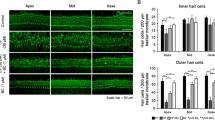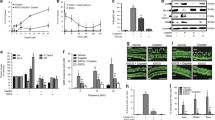Abstract
The 3-hydroxy-3-methylglutaryl-coenzyme A (HMG-CoA) reductase (HMGCR) gene encodes rate-limiting enzyme in cholesterol biosynthesis, which is related to cell proliferation and mitochondrial function. The present study was designed to explore the expression of HMGCR in murine cochlear hair cells and HEI-OC1 cells and the possible mechanisms underpinning the actions of HMGCR in cisplatin-induced ototoxicity, with special attention given to p38 mitogen-activated protein kinase (MAPK) activities in vitro. The expressions of HMGCR, p-p38, cleaved caspase-3 and LC3B was measured by immunofluorescence and western blot. JC-1 staining and MitoSOX Red were used to detect mitochondria membrane potential (MMP) and reactive oxygen species (ROS) levels respectively. The apoptosis of auditory cells was assessed by TUNEL staining and flow cytometry. Protein levels of bcl2/bax and beclin1 were examined by western blot. We found that HMGCR was widely expressed in the auditory cells, of both neonatal mice and 2-month-old mice, in cytoplasm, nucleus and stereocilia. Moreover, 30 μM cisplatin elicited the formation of ROS, which, in turn, led to HMGCR reduction, activating p38 kinase-related apoptosis and autophagy in auditory cells. Meanwhile, co-treatment with ROS scavenger at a concentration of 2 mM, N-acetyl-L-cysteine (NAC), could alleviate the aforementioned changes. In addition, HMGCR silencing resulted in higher p38 MAPK-mediated apoptosis and autophagy under cisplatin injury. Taken together, we demonstrate that, for the first time, that HMGCR is expressed in the cochlear. Furthermore, HMGCR exerts protective benefit on auditory cells against cisplatin-mediated injury stimulated by ROS, culminating in regulation of p38 MAPK-dependent apoptosis and autophagy.







Similar content being viewed by others
Data availability
The datasets generated during and/or analyzed during the current study are available from the corresponding author on request.
References
Achkar IW, Abdulrahman N, Al-Sulaiti H, Joseph JM, Uddin S, Mraiche F (2018) Cisplatin based therapy: the role of the mitogen activated protein kinase signaling pathway. J Transl Med 16(1):96. https://doi.org/10.1186/s12967-018-1471-1
Allenbach Y, Benveniste O, Stenzel W, Boyer O (2020) Immune-mediated necrotizing myopathy: clinical features and pathogenesis. Nat Rev Rheumatol 16(12):689–701. https://doi.org/10.1038/s41584-020-00515-9
Bu C, Xu L, Han Y et al (2022) c-Myb protects cochlear hair cells from cisplatin-induced damage via the PI3K/Akt signaling pathway. Cell Death Discov 8(1):78. https://doi.org/10.1038/s41420-022-00879-9
Ching JK, Ju JS, Pittman SK, Margeta M, Weihl CC (2013) Increased autophagy accelerates colchicine-induced muscle toxicity. Autophagy 9(12):2115–2125. https://doi.org/10.4161/auto.26150
De Giorgi M, Jarrett KE, Burton JC et al (2020) Depletion of essential isoprenoids and ER stress induction following acute liver-specific deletion of HMG-CoA reductase. J Lipid Res 61(12):1675–1686. https://doi.org/10.1194/jlr.RA120001006
DeBacker JR, McMillan GP, Martchenke N et al (2023) Ototoxicity prognostic models in adult and pediatric cancer patients: a rapid review. J Cancer Surviv 17(1):82–100. https://doi.org/10.1007/s11764-022-01315-8
Du P, Liu T, Luo P et al (2023) SIRT3/GLUT4 signaling activation by metformin protect against cisplatin-induced ototoxicity in vitro. Arch Toxicol 97(4):1147–1162. https://doi.org/10.1007/s00204-023-03457-9
Fu X, Li P, Zhang L et al (2022) Activation of Rictor/mTORC2 signaling acts as a pivotal strategy to protect against sensorineural hearing loss. Proc Natl Acad Sci U S A 119(10):e2107357119. https://doi.org/10.1073/pnas.2107357119
GBDA Collaborators (2022) Global, regional, and national burden of diseases and injuries for adults 70 years and older: systematic analysis for the Global Burden of Disease 2019 Study. BMJ 376:e068208. https://doi.org/10.1136/bmj-2021-068208
GBDHL Collaborators (2021) Hearing loss prevalence and years lived with disability, 1990–2019: findings from the Global Burden of Disease Study 2019. Lancet 397(10278):996–1009. https://doi.org/10.1016/S0140-6736(21)00516-X
Gibaja A, Alvarado JC, Scheper V, Carles L, Juiz JM (2022) Kanamycin and cisplatin ototoxicity: differences in patterns of oxidative stress, antioxidant enzyme expression and hair cell loss in the cochlea. Antioxidants (basel). https://doi.org/10.3390/antiox11091759
He D, Wu H, Xiang J et al (2020) Gut stem cell aging is driven by mTORC1 via a p38 MAPK-p53 pathway. Nat Commun 11(1):37. https://doi.org/10.1038/s41467-019-13911-x
Istvan ES, Palnitkar M, Buchanan SK, Deisenhofer J (2000) Crystal structure of the catalytic portion of human HMG-CoA reductase: insights into regulation of activity and catalysis. EMBO J 19(5):819–830. https://doi.org/10.1093/emboj/19.5.819
Liu W, Xu L, Wang X et al (2021) PRDX1 activates autophagy via the PTEN-AKT signaling pathway to protect against cisplatin-induced spiral ganglion neuron damage. Autophagy 17(12):4159–4181. https://doi.org/10.1080/15548627.2021.1905466
Lu XY, Shi XJ, Hu A et al (2020) Feeding induces cholesterol biosynthesis via the mTORC1-USP20-HMGCR axis. Nature 588(7838):479–484. https://doi.org/10.1038/s41586-020-2928-y
Ormsby TJR, Owens SE, Turner ML, Cronin JG, Bromfield JJ, Sheldon IM (2023) Glucocorticoids increase tissue cell protection against pore-forming toxins from pathogenic bacteria. Commun Biol 6(1):186. https://doi.org/10.1038/s42003-023-04568-w
Pokhrel RH, Acharya S, Ahn JH et al (2021) AMPK promotes antitumor immunity by downregulating PD-1 in regulatory T cells via the HMGCR/p38 signaling pathway. Mol Cancer 20(1):133. https://doi.org/10.1186/s12943-021-01420-9
Ramkumar V, Mukherjea D, Dhukhwa A, Rybak LP (2021) Oxidative stress and inflammation caused by cisplatin ototoxicity. Antioxidants (basel). https://doi.org/10.3390/antiox10121919
Rosoff DB, Bell AS, Jung J, Wagner J, Mavromatis LA, Lohoff FW (2022) Mendelian randomization study of PCSK9 and HMG-CoA reductase inhibition and cognitive function. J Am Coll Cardiol 80(7):653–662. https://doi.org/10.1016/j.jacc.2022.05.041
Wang H, Lin C, Yao J et al (2019) Deletion of OSBPL2 in auditory cells increases cholesterol biosynthesis and drives reactive oxygen species production by inhibiting AMPK activity. Cell Death Dis 10(9):627. https://doi.org/10.1038/s41419-019-1858-9
Wang HY, Yu P, Chen XS et al (2022) Identification of HMGCR as the anticancer target of physapubenolide against melanoma cells by in silico target prediction. Acta Pharmacol Sin 43(6):1594–1604. https://doi.org/10.1038/s41401-021-00745-x
Wang X, Zhou Y, Wang D et al (2023a) Cisplatin-induced ototoxicity: from signaling network to therapeutic targets. Biomed Pharmacother 157:114045. https://doi.org/10.1016/j.biopha.2022.114045
Wang Y, Zhao H, Wang F et al (2023b) DJ-1 Protects auditory cells from cisplatin-induced ototoxicity via regulating apoptosis and autophagy. Toxicol Lett 379:56–66. https://doi.org/10.1016/j.toxlet.2023.03.010
Wei T, Xiaojun X, Peilong C (2020) Magnoflorine improves sensitivity to doxorubicin (DOX) of breast cancer cells via inducing apoptosis and autophagy through AKT/mTOR and p38 signaling pathways. Biomed Pharmacother 121:109139. https://doi.org/10.1016/j.biopha.2019.109139
Yang D, Xie P, Guo S, Li H (2010) Induction of MAPK phosphatase-1 by hypothermia inhibits TNF-alpha-induced endothelial barrier dysfunction and apoptosis. Cardiovasc Res 85(3):520–529. https://doi.org/10.1093/cvr/cvp323
Yang Q, Sun G, Yin H et al (2018) PINK1 Protects auditory hair cells and spiral ganglion neurons from cisplatin-induced ototoxicity via inducing autophagy and inhibiting JNK signaling pathway. Free Radic Biol Med 120:342–355. https://doi.org/10.1016/j.freeradbiomed.2018.02.025
Yeganeh B, Wiechec E, Ande SR et al (2014) Targeting the mevalonate cascade as a new therapeutic approach in heart disease, cancer and pulmonary disease. Pharmacol Ther 143(1):87–110. https://doi.org/10.1016/j.pharmthera.2014.02.007
Zhang Y, Fang Q, Wang H et al (2023) Increased mitophagy protects cochlear hair cells from aminoglycoside-induced damage. Autophagy 19(1):75–91. https://doi.org/10.1080/15548627.2022.2062872
Zhao H, Xu Y, Song X et al (2022) Cisplatin induces damage of auditory cells: possible relation with dynamic variation in calcium homeostasis and responding channels. Eur J Pharmacol 914:174662. https://doi.org/10.1016/j.ejphar.2021.174662
Zhong Z, Fu X, Li H et al (2020) Citicoline protects auditory hair cells against neomycin-induced damage. Front Cell Dev Biol 8:712. https://doi.org/10.3389/fcell.2020.00712
Acknowledgements
HEI-OC1 cell line was kindly provided by Qingyin Zheng, Department of Otolaryngology-HNS, Case Western Reserve University, Cleveland, OH, USA.
Funding
This work was supported by the National Natural Science Foundation of China (Nos. 82071039; 82101215, 82201293).
Author information
Authors and Affiliations
Contributions
YL: conceived of or designed study, performed research and wrote the paper. HY, HN, FW and YW: contributed new methods or models. YX, JZ, HZ and ZC: analyzed data. QY: conceived of or designed study and revised the article. JL: conceived of or designed study, revised the article and approved the final version.
Corresponding authors
Ethics declarations
Conflict of interest
The authors declare that they have no conflict of interest.
Ethics approval
The manuscript does not contain clinical studies or patient data.
Additional information
Publisher's Note
Springer Nature remains neutral with regard to jurisdictional claims in published maps and institutional affiliations.
Rights and permissions
Springer Nature or its licensor (e.g. a society or other partner) holds exclusive rights to this article under a publishing agreement with the author(s) or other rightsholder(s); author self-archiving of the accepted manuscript version of this article is solely governed by the terms of such publishing agreement and applicable law.
About this article
Cite this article
Li, Y., Yang, H., Nong, H. et al. 3-hydroxy-3-methylglutaryl-coenzyme A (HMG-CoA) reductase (HMGCR) protects hair cells from cisplatin‐induced ototoxicity in vitro: possible relation to the activities of p38 MAPK signaling pathway. Arch Toxicol 97, 2955–2967 (2023). https://doi.org/10.1007/s00204-023-03588-z
Received:
Accepted:
Published:
Issue Date:
DOI: https://doi.org/10.1007/s00204-023-03588-z




